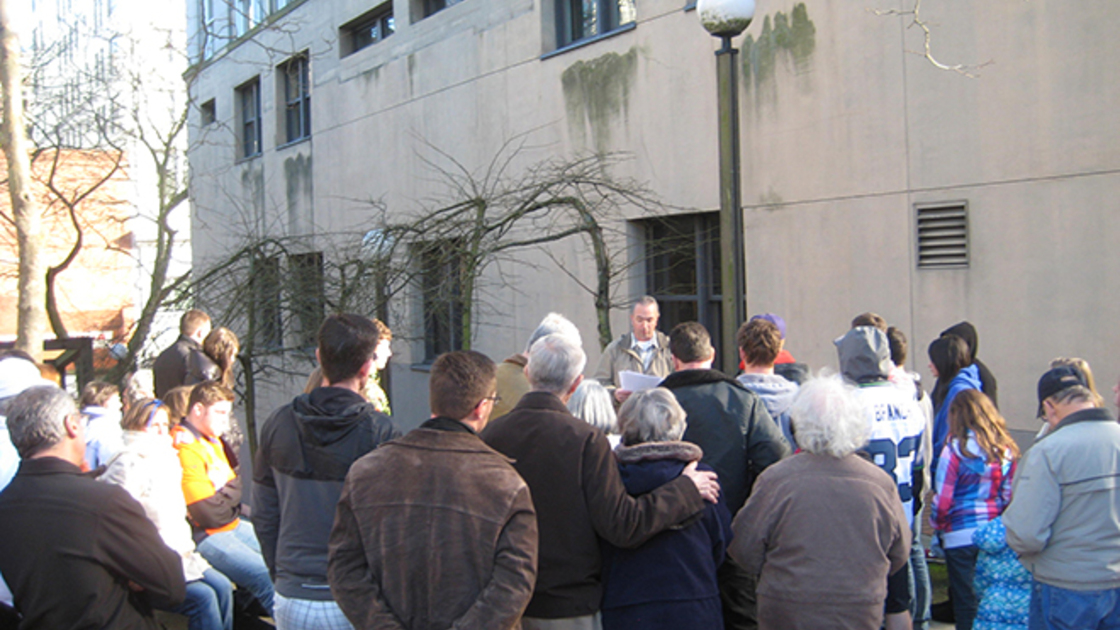WASHINGTON—Early on February 2, seniors, parents, teens and young children embarked on a historic tour of Seattle. Aboard a rented school bus filled to capacity, they rolled out of the Tacoma Mall to destinations that held significance in the church’s Philadelphia era, led by Herbert W. Armstrong.
The tour included important sites in Seattle, Everett and Tacoma where Mr. Armstrong worked beginning in the 1940s and into the early 1980s. Narrated with quotations of letters and advertisements written by Mr. Armstrong, the tour included photos of him at some of the locations.
“The 1940s proved to be a wonderful time in church history,” the tour brochure read, “as God guided His end-time Elijah through open doors and miracles to continue to grow His Work and to lead it on a path to reaching the largest audience possible. Fast forward to 1981, and God through Mr. Armstrong was working on trying to get the Worldwide Church of God back on track.”
The bus drove by Boeing Field. As the tour group learned, this is where Mr. Armstrong said he would never fly unless he had to do so for God’s Work, and then he would trust God to protect him. Once, Mr. Armstrong had to go quickly from Seattle to Portland for a broadcast, and his only option was to fly. Halfway through that first flight, the captain came through the cabin, speaking quietly into each passenger’s ear the alarming news he had just heard over the radio: The Japanese were attacking Pearl Harbor. That was December 7, 1941.
The members also visited the site of the krsc radio station. As they huddled together in freezing temperatures, they learned how the Radio Church of God expanded outside of Oregon and went on the air in Seattle for the first time on Sept. 15, 1940. Years later, that same message would be broadcast around the world.
Next they saw Seattle’s Great Northern Railway station, where Mr. Armstrong had boarded the Empire Builder to travel east. He visited radio station managers along the way to increase the reach of the gospel message. The station was adjacent to the Seattle Seahawks football stadium, and surrounding streets were full of cheering Super Bowl fans.
“I was inspired by seeing how far Mr. Armstrong traveled to do the work,” Lois Blair said.
The group walked a block to the Seattle Chamber of Commerce Auditorium, where Mr. Armstrong often spoke to radio-listening audiences. In view of the spectacular snowcapped Cascade Mountains, they went on to the former site of the Everett church building, now the location of a county jail. Everett Church of God members had purchased a building there in late 1941, and Mr. Armstrong held services for about 15 adults and 15 children, as well as evangelistic campaigns. They also visited the Everett Post Office, which Mr. Armstrong also used.
Next, the group saw the Seattle Center Exhibition Hall, where Mr. Armstrong spoke in the early 1980s as he was combatting problems in the church. Several longtime members were there and shared their memories of that day.
Mercer Arena, located in the modern architecture of Seattle’s performing arts district, was the next stop. This was the site of the Feast of Tabernacles in 1978 and 1979. Several members of the group had attended those festivals, which the Seattle Times said included as many as 6,000 members.
The next stop jumped back in time to 1943, when Mr. Armstrong said the door to broadcast on kvi Tacoma radio suddenly opened. This was an answered prayer that afforded coverage to Vancouver, B.C., Canada.
Finally, the group wound up back at the Tacoma Mall at a doughnut shop, the former location of a theater where about 350 Worldwide Church of God members met for services in 1970 and 1978.
“I don’t know any of this history, but it sure was inspiring,” the hired bus driver, Keith, said.
Additional church history tours in 2014 are planned for the historic sites in the cities of Vancouver, Wash., and Portland, Salem and Eugene, Ore.
Two weeks after the tour, member Jamie Jameson said, “It was so inspiring we are still talking about it!”
